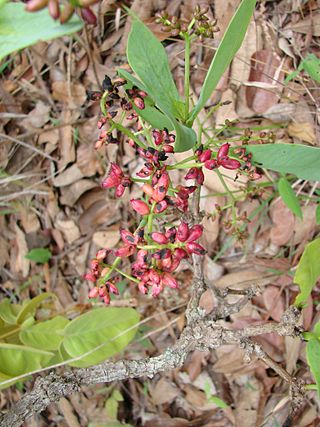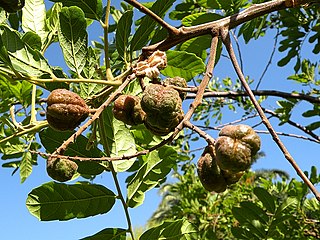
Sebastiania is a genus of flowering plants in the family Euphorbiaceae first described in 1821. It is native to North and South America from Arizona and the West Indies south to Uruguay.

Tilioideae is a flowering plant subfamily in the family Malvaceae, though it was formerly considered a large group, placed at family rank and called Tiliaceae.

Schoepfia is a genus of small hemiparasitic trees, flowering plants belonging to the family Schoepfiaceae. The genus has long been placed in the Olacaceae family.
Chamguava is a genus of the botanical family Myrtaceae, first described as a genus in 1991. It is native to southern Mexico and Central America.
- Chamguava gentlei(Lundell) Landrum - Chiapas, Belize, Guatemala, Honduras
- Chamguava musarum(Standl. & Steyerm.) Landrum - Guatemala
- Chamguava schippii(Standl.) Landrum - Guerrero, Chiapas, Belize, Guatemala, Panama

Neea is a genus of plants in family Nyctaginaceae from the Caribbean region, Central and South America. Members of the genus are commonly called Nia, Neea, or saltwood.
Conrad Vernon Morton was an American botanist, who did notable writings on ferns. He was also a specialist in Gesneriaceae and Solanaceae for the Smithsonian Institution from 1928.

Chiococca is a genus of flowering plants in the family Rubiaceae. It currently holds 23 species that are native to Florida, Texas, Mexico, Central America, much of South America, the West Indies, and the islands of Galápagos and Fernando de Noronha.

Cupania is a genus of flowering plants in the family Sapindaceae. It includes 58 species native to the tropical Americas, ranging from Mexico and south Florida through Central America, the Caribbean, and South America to northern Argentina.
Thinouia is a genus of flowering plants belonging to the family Sapindaceae. It is also in the Sapindoideae subfamily and Paullinieae tribe.
Tecunumania is a genus of flowering plants belonging to the family Cucurbitaceae.

Matayba is a genus of flowering plants belonging to the family Sapindaceae.
Sommera is a genus of flowering plants belonging to the family Rubiaceae.
Seymeria is a genus of flowering plants belonging to the family Orobanchaceae.

Ruyschia is a genus of flowering plants belonging to the family Marcgraviaceae.
Pisoniella is a monotypic genus of flowering plants belonging to the family Nyctaginaceae. It only contains one known species, Pisoniella arborescens(Lag. & Rodr.) Standl.
Ruizterania is a genus of flowering plants belonging to the family Vochysiaceae.
Romanschulzia is a genus of flowering plants belonging to the family Brassicaceae.
Stanmarkia is a genus of flowering plants belonging to the family Melastomataceae.
Schultesianthus is a genus of flowering plants belonging to the family Solanaceae.
Orthion is a genus of flowering plants belonging to the family Violaceae.






